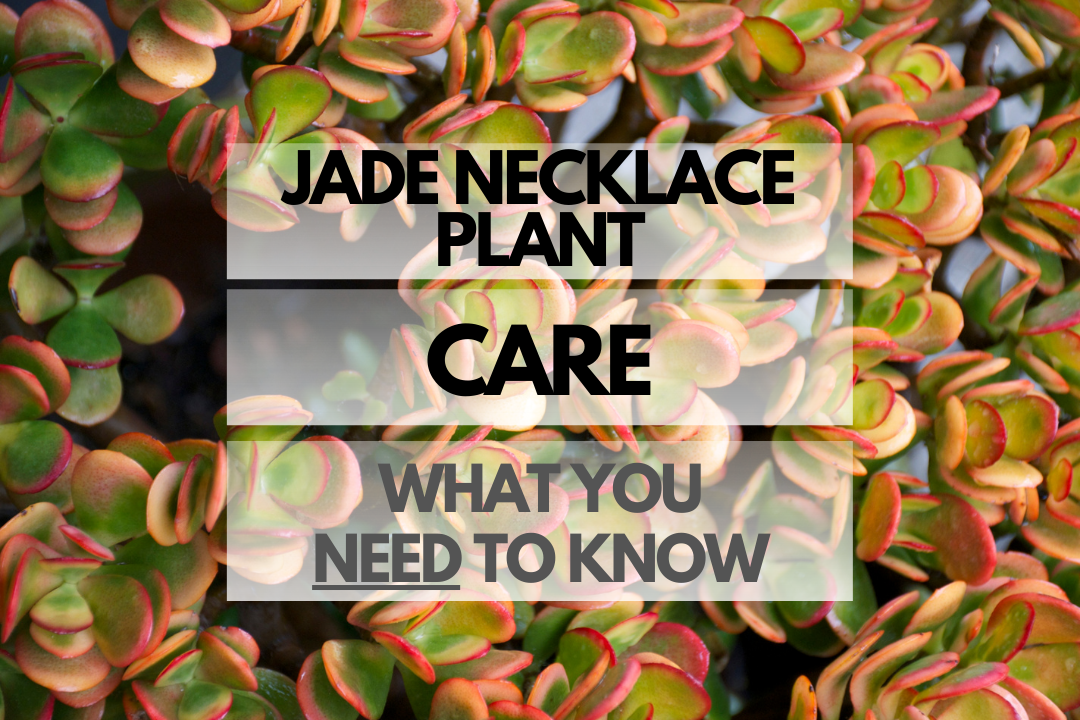Are you looking for an interesting, low-maintenance succulent to add to your collection? Look no further than the Jade Necklace Plant! This unique and charming plant is easy to care for and adds a touch of whimsy to any space. In this article, we’ll provide all the information you need to help your Jade Necklace Plant thrive. Let’s get started!
Jade Necklace Plant Care Guide
Quick Reference Table: Caring for Jade Necklace Plant
| Aspect | Details |
|---|---|
| Sunlight | Bright, indirect light; some direct morning or late afternoon sun is beneficial |
| Soil | Well-draining cactus or succulent mix, or create your own mixture with sand, perlite, or pumice |
| Watering | Water thoroughly when the top 1-2 inches of soil is dry; reduce watering in winter |
| Pruning | Trim any dead or damaged leaves or stems, and pinch back to encourage bushier growth |
| Temperature | Optimal range is 65-80°F (18-27°C); not cold-hardy and should be brought indoors if temperatures drop below 40°F (4°C) |
| Common Problems | Overwatering, pests, sunburn |
| Indoors vs Outdoors | Can be grown both indoors and outdoors, with different benefits and challenges |
| Best Pots | Terra-cotta or ceramic pots with drainage holes |
Jade Necklace Plant Sunlight: Do They Need It and How Much?
Jade Necklace Plants thrive in bright, indirect light. They can also tolerate some direct morning or late afternoon sun, which is beneficial for their growth. However, be cautious of prolonged exposure to intense midday sun, as it can cause sunburn on the leaves.
Jade Necklace Plant Soil Tips
These succulents require well-draining soil to prevent root rot. You can use a cactus or succulent mix, or create your own mixture by combining regular potting soil with sand, perlite, or pumice. This will ensure that excess water drains away from the roots quickly, keeping your Jade Necklace Plant healthy.
Jade Necklace Plant Watering and Frequency
Water your Jade Necklace Plant thoroughly when the top 1-2 inches of soil feels dry to the touch. It’s essential to let the soil dry out between waterings to prevent overwatering, which can lead to root rot. During the winter months, when the plant is dormant, you can reduce the watering frequency.
Pruning Jade Necklace Plant Properly
Pruning your Jade Necklace Plant is relatively simple. Trim any dead or damaged leaves or stems to keep the plant looking neat and tidy. You can also pinch back the tips of the stems to encourage bushier growth and maintain the desired shape.
Optimal Jade Necklace Plant Temperature: Can They Tolerate the Cold?
Jade Necklace Plants prefer temperatures between 65-80°F (18-27°C) and are not cold-hardy. If you live in an area where temperatures drop below 40°F (4°C) during winter, it’s best to bring your Jade Necklace Plant indoors. Placing the plant near a bright window will help it continue to receive the light it needs to thrive.
Common Jade Necklace Plant Problems
Overwatering
One of the most common issues with Jade Necklace Plants is overwatering, which can lead to root rot. To avoid this problem, allow the soil to dry out between waterings and ensure you’re using a well-draining soil mix.
Pests
Mealybugs, aphids, and spider mites can occasionally infest Jade Necklace Plants. Keep an eye out for these pests and treat them promptly with insecticidal soap or a solution of water andmild dish soap. Regularly inspect your plant for signs of pests, and isolate any affected plants to prevent the spread of infestations.
Sunburn
While Jade Necklace Plants enjoy bright light, too much direct sunlight can cause sunburn on their leaves. Protect your plant from intense midday sun by placing it in partial shade or filtering the sunlight through a sheer curtain.
Jade Necklace Plant Outdoors vs Indoors
Jade Necklace Plants can be grown both indoors and outdoors, with each environment offering its own benefits and challenges.
| Environment | Pros | Cons |
|---|---|---|
| Indoors |
|
|
| Outdoors |
|
|
Best Pots for Jade Necklace Plant
When choosing a pot for your Jade Necklace Plant, it’s important to select one with drainage holes to prevent water from sitting in the bottom of the pot, which can lead to root rot. Terra-cotta or ceramic pots are excellent choices, as they allow excess moisture to evaporate through their porous surfaces. Be sure to choose a pot that’s appropriately sized for your plant, with enough room for the roots to spread and grow.
Jade Necklace Plant Facts
Jade Necklace Plant Benefits
- Low Maintenance: Jade Necklace Plants are easy to care for, making them perfect for beginners or busy plant parents.
- Air Purifying: Like many other succulents, Jade Necklace Plants can help improve indoor air quality by removing toxins.
- Unique Appearance: With their interesting, trailing growth habit and bead-like leaves, Jade Necklace Plants add a touch of whimsy to any space.
Growth Rates: How Fast Do They Grow?
Jade Necklace Plants are relatively slow-growing succulents. With proper care, they can grow about 2-4 inches (5-10 cm) per year. Their trailing stems can eventually reach up to 2 feet (60 cm) long.
Jade Necklace Plant Lifespan
With proper care, Jade Necklace Plants can live for several years. Their lifespan can be extended by providing the right growing conditions, such as proper sunlight, well-draining soil, and appropriate watering.
Are Jade Necklace Plants Safe?
Jade Necklace Plants are generally considered safe and non-toxic to humans and pets. However, it’s always best to keep them out of reach of curious children and pets, as ingesting any plant material could potentially cause discomfort.
Jade Necklace Plant Flowers
Jade Necklace Plants can produce small, star-shaped flowers in shades of yellow or orange. The flowers typically appear in clusters at the tips of the stems and can bloom throughout the year, depending on the growing conditions.
Jade Necklace Plant Types and Varieties
While the Jade Necklace Plant is a unique and visually interesting plant on its own, there are also several other closely related varieties worth considering:
Crassula rupestris
Also known as the “Baby’s Necklace,” Crassula rupestris has similar bead-like leaves as the Jade Necklace Plant, but with a more compact growth habit. The leaves are usually green with red margins, adding a pop of color to your succulent collection.
Crassula perforata
Commonly called the “String of Buttons” or “Stacked Crassula,” Crassula perforata has triangular leaves that grow in opposing pairs along the stems. This variety can produce small, white flowers in the spring or summer.
Crassula marnieriana
Also known as the “Worm Plant” or “Jade Necklace Vine,” Crassula marnieriana has a similar growth habit to the Jade Necklace Plant, with its bead-like leaves appearing more elongated and delicate. This variety is also known for its red-tinged leaf margins.
Jade Necklace Plant Pros and Cons
| Pros | Cons |
|---|---|
|
|
Jade Necklace Plant Cost
The cost of a Jade Necklace Plant can vary depending on the size and condition of the plant. Small, starter-sized plants can typically be purchased for around $5-$10, while larger, more established plants may cost $20 or more.
Where to Buy Jade Necklace Plants
Jade Necklace Plants can be found at local nurseries, garden centers, or online plant retailers. Specialty succulent nurseries may also carry them, and they are often available for purchase at plant swap events or through online plant trading communities.
Is Jade Necklace Plant Propagation in Water Possible?
While it is possible to propagate Jade Necklace Plants in water, they tend to root more successfully in soil. To propagate, simply take a healthy stem cutting, let it callus over for a few days, and then place it in well-draining soil. Keep the soil slightly moist, and you should see new roots forming within a few weeks.
Additional Resources
- Crassula Care – Jade Plant Care and Growing Tips
- Facebook Group – Succulent Lovers
- GardenWeb Forum – Succulents
- Reddit – r/succulents
- The Complete Book of Cacti & Succulents by Terry Hewitt
FAQ for Jade Necklace Plant Care
Are Jade Necklace Plants toxic to cats?
No, Jade Necklace Plants are considered non-toxic to cats. However, it’s always a good idea to keep plants out of reach of curious pets.
Are Jade Necklace Plants toxic to dogs?
No, Jade Necklace Plants are considered non-toxic to dogs. It’s still best to keep them away from your pets to prevent any potential issues.
Are Jade Necklace Plants toxic to kids?
Jade Necklace Plants are non-toxic to humans, including children. However, it’s always a good idea to teach kids not to eat plants and to keep plants out of their reach.
How tall do Jade Necklace Plants get?
Jade Necklace Plants typically grow 2-4 inches (5-10 cm) per year, with trailing stems that can reach up to 2 feet (60 cm) long.
Can Jade Necklace Plants live outside?
Jade Necklace Plants can be grown outdoors in warm climates, as long as they are protected from frost and extreme temperatures. They prefer a sunny location with some afternoon shade to prevent sunburn.
Are Jade Necklace Plants poisonous?
No, Jade Necklace Plants are not considered poisonous. They are generally safe for humans and pets, but it’s always best to keep them out of reach just in case.
How often should I water my Jade Necklace Plant?
Water your Jade Necklace Plant when the soil is completely dry, usually about once every 2-3 weeks. Be careful not to overwater, as this can lead to root rot and other issues.
What type of soil is best for Jade Necklace Plants?
Use a well-draining soil mix designed for succulents, or make your own by combining equal parts potting soil, perlite, and coarse sand. This will ensure proper drainage and prevent root rot.

